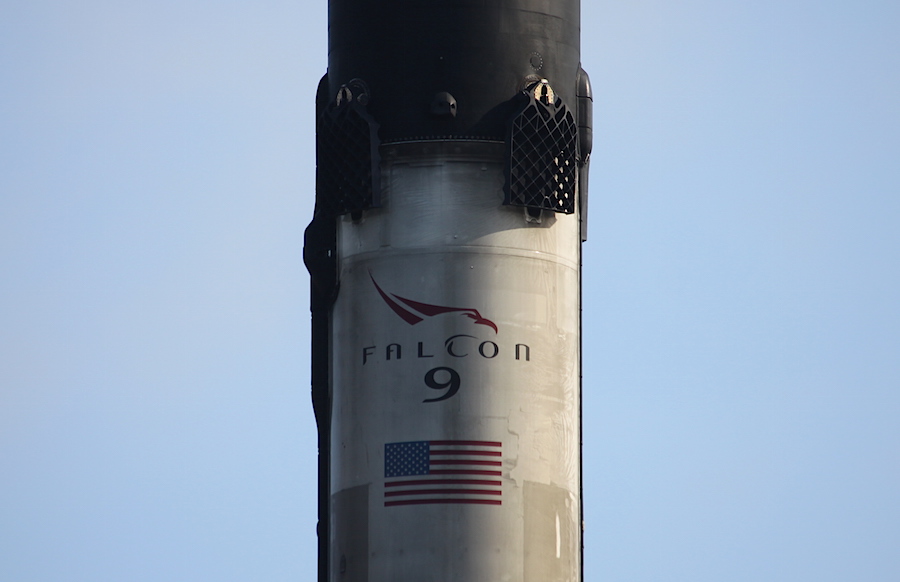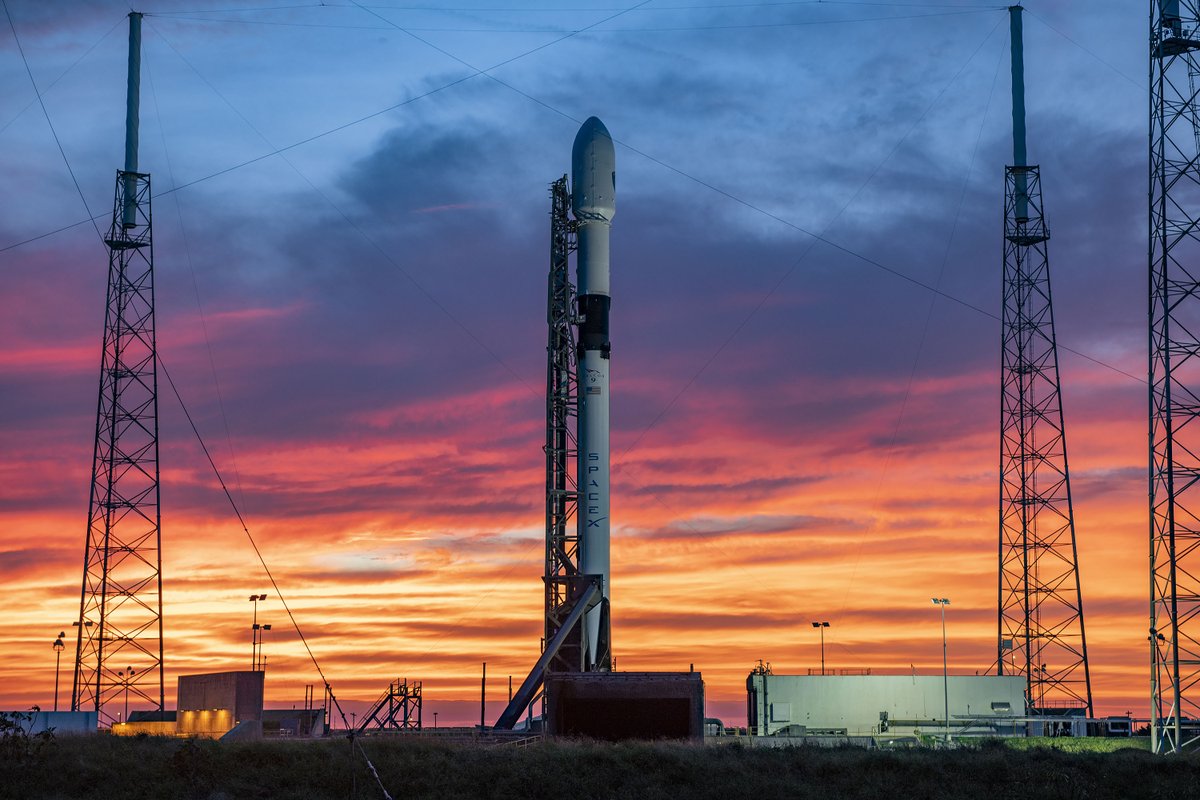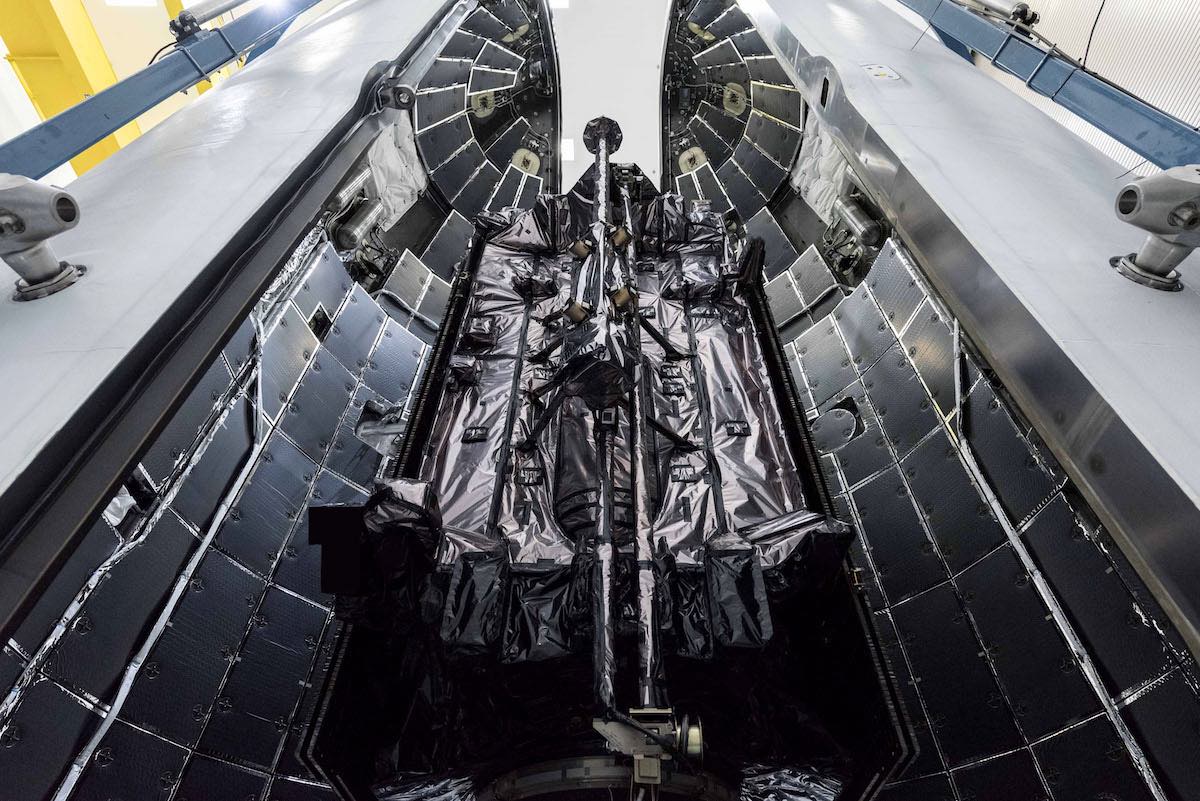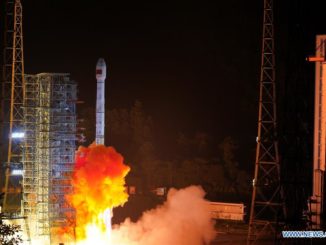
The U.S. Space Force says it will launch two GPS navigation satellites on reused Falcon 9 boosters next year through a restructured contract with SpaceX that saved taxpayers $52 million, the first time the military has agreed to fly operational national security payloads on previously-flown rockets.
The Space Force’s Space and Missile Systems Center, or SMC, signed an updated contract with SpaceX in September to cover the agreement to fly the two GPS satellites on reused Falcon 9 boosters, according to Walter Lauderdale, chief of SMC’s Falcon Systems and Operations Division, and a frequent mission director.
“SMC’s commitment to innovative partnerships and working with the commercial sector while maintaining our mission assurance posture and mission-success record cannot be understated,” Lauderdale said in a Space Force statement. “I am proud of our partnership with SpaceX that allowed us to successfully negotiate contract modifications for the upcoming GPS 3 missions that will save taxpayers $52.7 million while maintaining our unprecedented record of success.”
SpaceX and the Space Force plan to re-fly the Falcon 9 booster set for launch Friday night with the GPS 3 SV04 navigation satellite on a mission next year with the GPS 3 SV05 spacecraft, the next member of the GPS navigation constellation.
A reused Falcon 9 first stage will also launch the GPS 3 SV06 mission, likely to launch in late 2021 or early 2022.
“SpaceX is proud to leverage Falcon 9’s flight-proven benefits and capabilities for national security space launch missions,” said Gwynne Shotwell, SpaceX’s president and chief operating officer. “We appreciate the effort that the U.S. Space Force invested into the evaluation and are pleased that they see the benefits of the technology. Our extensive experience with reuse has allowed SpaceX to continually upgrade the fleet and save significant precious tax dollars on these launches.”
Two of the Space Force’s first three new-generation GPS 3-series navigation satellites have launched on Falcon 9 rockets from SpaceX. Another GPS 3 satellite lifted off on Delta 4 rocket from SpaceX rival United Launch Alliance.
The GPS 3 SV04 satellite is scheduled to take off at 9:43 p.m. EDT Friday (0143 GMT Saturday) on top of a Falcon 9 rocket from pad 40 at Cape Canaveral Air Force Station. There is a 15-minute launch window Friday night.
The launch from Cape Canaveral Friday night is set to occur just 27 minutes after a Northrop Grumman Antares rocket is scheduled to take off from Wallops Island, Virginia, to kick off a commercial resupply mission to the International Space Station. The GPS and space station cargo missions are unrelated, but the close proximity of their launch times Friday is noteworthy.

Like the two previous GPS satellites launched by SpaceX, the GPS 3 SV04 mission will fly with a brand new Falcon 9 first stage.
The reusable first stage will shut down and separate from the Falcon 9’s upper stage around two-and-a-half minutes into the mission. Around eight-and-a-half minutes after liftoff, SpaceX plans to land the autonomous booster on a drone ship positioned in the Atlantic Ocean a few hundred miles northeast of Cape Canaveral.
Meanwhile, the Falcon 9’s single-use upper stage will ignite two times to inject the Lockheed Martin-built GPS 3 SV04 satellite into an elliptical orbit ranging between about 250 miles (400 kilometers) and 12,550 miles (20,200 kilometers) in altitude. The Falcon 9’s on-board computer will aim to release the GPS 3 SV04 satellite nearly 90 minutes after launch into an orbit inclined 55 degrees to the equator.
The nearly five-ton spacecraft will use its on-board engine to circularize its orbit to join 31 operational GPS satellites 12,550 miles above Earth. If all goes according to plan, the GPS 3 SV04 spacecraft should be ready by mid-October to provide positioning, navigation and timing services to billions of users around the world, according to Col. Edward Byrne, SMC’s, Medium Earth Orbit Space Systems Division chief.
The GPS 3-series satellites are designed for 15-year life spans, an improvement over the seven-and-a-half year and 12-year design lives of previous-generation GPS satellites.
SpaceX has flown 42 reused Falcon boosters to date, all successfully.
Last year, the military agreed to launch a cluster of experimental payloads on a Falcon Heavy rocket powered by two reused side boosters. But before now, the Space Force had not approved launches of its most critical national security satellites on previously-flown rockets.
That made the Space Force the last SpaceX customer to insist on flying some of its satellites on brand new rockets. NASA announced earlier this year it agreed to launch future Crew Dragon missions with astronauts on reused capsules and re-flown Falcon 9 boosters.
The military required SpaceX to dispose of its Falcon 9 booster on a GPS satellite launch in December 2018. Military officials then wanted to maximize the Falcon 9 rocket’s lift capability to place the GPS satellite into a higher-altitude orbit.
The military relaxed those requirements for the next launch of a GPS satellite with SpaceX on June 30. The perigee, or low point, of the GPS satellite’s initial orbit after separating from the Falcon 9’s upper stage was lowered by about 500 miles, or 800 kilometers.
That ensured the Falcon 9 rocket’s first stage had enough leftover fuel to perform descent maneuvers and land on an offshore drone ship in the Atlantic Ocean. Lauderdale said in June that the agreement to permit recovery of the first stage saved the military “several million dollars.”
Factoring in the changes to allow booster recovery on four GPS missions beginning with the June 30 launch, and then rocket reuse on two GPS missions beginning next year, the updated launch contracts between the Space Force and SpaceX resulted in $52.7 million in savings, officials said.

The Space Force awarded contracts to United Launch Alliance and SpaceX in August for dozens of additional national security satellite launches through 2027. The military previously said it would allow launch providers to reuse rocket hardware for those missions, which begin flying no earlier than 2022.
Lauderdale said Sept. 25 that the Space Force will perform a “non-recurring design validation review” of SpaceX’s rocket refurbishment and reuse practices over the coming months. The one-time review will help the military gain insight and confidence in SpaceX’s rocket reuse program before the launch of the GPS 3 SV05 mission next year.
Based on the current plan, the GPS 3 SV05 satellite will launch on the same first stage booster set to blast off Friday with the GPS SV04 mission.
Compared to many commercial satellite operators, the Space Force performs additional oversight of its launch contractors due to the high cost and criticality of its payloads for U.S. national security.
“This is our journey in understanding how SpaceX executes refurbishment of previously-flown hardware,” Lauderdale said. “We would then compare that to the qualification. It’s learning and then assessing all the work that they do in order to get these boosters ready to fly again.
“So that requires review of a number of different systems and making sure that we’re good across the board with previously-flown hardware, not just this particular booster,” Lauderdale said.
Space Force engineers will evaluate how the Falcon 9 boosters weather multiple flights.
“Basically, we’re going through and understanding what the vehicle sees, (and) compare that against qualification,” Lauderdale said. “What’s the life that you can get out of the booster? That’s what we’re trying to understand. And then what we do in partnership with SpaceX is we’re able to assess any environment that the vehicle sees … and make sure that we’re confident it’s ready to fly again.”
After establishing new technical criteria and requirements for reused rockets, SpaceX and the Space Force will assign certain boosters from the Falcon 9 inventory to fly on national security missions, Lauderdale said.
“So it really does establish that framework and an understanding of what technical data we need to evaluate to assess the flight-worthiness of it to fly again,” Lauderdale said. “They will then use that in partnership with us to assign vehicles that make sense for our missions. This is a true partnership in terms of making sure that we balance their commercial manifest against our requirements to best effect.
“We care about which particular booster we’re flying,” Lauderdale said. “When we go through and look at the criteria and look at what we’re concerned with, SpaceX will account for that in designating a vehicle for our use.”
That is a different approach from many of SpaceX’s commercial customers, which have less say in the company’s refurbishment plan. Government customers like NASA and the Space Force pay their launch providers extra money for added flexibility and insight.
Lauderdale said the Space Force is delaying the launch of the GPS 3 SV05 mission from late January to early July 2021 to allow more time for the military’s design review of SpaceX’s reusable rocket program. He said doing the review now gives the Space Force and SpaceX a head start in regularly flying national security missions on reused rockets in the future.
The Space Force awarded SpaceX an $8.9 million “fleet surveillance” contract in May to give the military more information on SpaceX processes and launch site activities for the company’s commercial missions.
“The fleet surveillance modification we made to the contract was to fill in a gap that we had what we originally put there to make sure we had complete coverage for the commercial launches, predominately for work that goes on down here at the launch site, as well as taking advantage of some unique tools that SpaceX can make available to us to help us with doing that fleet surveillance,” Lauderdale said Sept. 25.
“Since we’ve put it on contract, we’ve seen increased access and flexibility to understand and see what the contractor sees — to see what SpaceX sees — so that when we have our conversations about any observations — about anything that goes on with their commercial launches — we can quickly connect it and make a good independent assessment for our upcoming missions.”
The Space Force has not awarded launch contracts for the last four GPS 3-series satellites, SV07 through SV10. ULA and SpaceX are eligible to compete for the launch assignments.
Email the author.
Follow Stephen Clark on Twitter: @StephenClark1.



